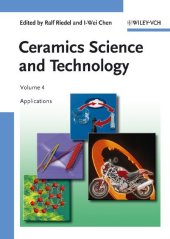 Neuerscheinungen 2013Stand: 2020-01-07 |
Schnellsuche
ISBN/Stichwort/Autor
|
Herderstraße 10
10625 Berlin
Tel.: 030 315 714 16
Fax 030 315 714 14
info@buchspektrum.de |

I-Wei Chen, Ralf Riedel
(Beteiligte)
Ceramics Science and Technology
Applications
Herausgegeben von Riedel, Ralf; Chen, I-Wei
1st ed. 2013. 544 S. 240 mm
Verlag/Jahr: WILEY-VCH 2013
ISBN: 3-527-31158-0 (3527311580)
Neue ISBN: 978-3-527-31158-3 (9783527311583)
Preis und Lieferzeit: Bitte klicken
PREFACE
PART ONE: Structural Applications
OXIDATION AND CORROSION OF CERAMICS
Introduction
Silica-Forming Ceramics
Alumina-Forming Ceramics
Ultrahigh-Temperature Ceramics
Oxide Ceramic Degradation Mechanisms
Concluding Remarks
THERMAL BARRIER COATINGS
Introduction
Manufacturing Routes
YSZ-Based TBCS
New TBC Systems
Summary
CERAMIC FILTERS AND MEMBRANES
Ceramics in Hot Gas Filtration
Ceramic Membranes for Liquid Filtration
Ceramic Membranes for Pervaporation/Vapor Permeation
Ceramic Membranes for Gas Separation
HIGH-TEMPERATURE ENGINEERING CERAMICS
Introduction
Engineering Ceramic Systems
Turbine Engine Applications
Applications for Rocket Propulsion and Hypersonic Vehicles
Friction Materials
Concluding Remarks: Barriers to Application
ADVANCED CERAMIC GLOW PLUGS
Introduction
Glow Plugs
Metal-Type Glow Plugs
Ceramic Glow Plugs
Fabrication Procedure of Heater Elements for Ceramic Glow Plugs
Material Design of the Ceramic Heater Element
Silicon Nitride Ceramics
Conclusions
NANOSIZED AND NANOSTRUCTURED HARD AND SUPERHARD MATERIALS AND COATINGS
Introduction: Small is Strong
Different Mechanisms of Hardness Enhancement in Coatings
Mechanisms of Decomposition of Solid Solution and Formation of Nanostructure
Industrial Applications of Nanocomposite and Nanostructured Coatings on Tools
Conclusions and Future Challenges
POLYMER-DERIVED CERAMICS: 40 YEARS OF RESEARCH AND INNOVATION IN ADVANCED CERAMICS
Introduction to Polymer-Derived Ceramics (PDCs)
Preceramic Polymer Synthesis
Processing of Preceramic Polymers
Microstructure of PDCs
Properties of PDCs
Applications of PDCs
Conclusions and Outlook
PART TWO: Functional Applications
MICROWAVE CERAMICS
Introduction
Microwave Dielectric Properties
Overview of Microwave Dielectric Materials
Crystal Chemistry of Perovskite and Tungsten-Bronze-Type Microwave Ceramics
Microstructural Features in High-Q Perovskites
Glass-Free Low-Temperature Co-Fired Ceramic LTCC Microwave Materials
CERAMIC FUEL CELLS: PRINCIPLES, MATERIALS, AND APPLICATIONS
Introduction
Fuel Cell Systems Efficiency and the Role of Ceramic Fuel Cells
Ceramic Fuel Cell Systems and Applications to Date
Efficiency and Principles of Ceramic Fuel Cells
Historical Overview of Ceramic Fuel Cells
SOFC Materials and Properties
New Approaches for Ceramic Fuel Cells
Concluding Remarks
NITRIDOSILICATES AND OXONITRIDOSILICATES: FROM CERAMIC MATERIALS TO STRUCTURAL AND FUNCTIONAL DIVERSITY
Introduction
Synthetic Approaches
1D Nitridosilicates
2D Nitridosilicates
3D Nitridosilicates
Chemical Bonding in Nitridosilicates
Material Properties
Outlook
CERAMIC LIGHTING
Introduction
Solid-State Lighting and White Light-Emitting Diodes
Ceramic Phosphors
White Light-Emitting Diodes Using Ceramic Phosphors
Outlook
CERAMIC GAS SENSORS
Introduction: Definitions and Classifications
Metal-Oxide-Based Gas Sensors: Operational Principles and Sensing Materials
Performance Characteristics
Nano-Micro Integration
Mechanism of Gas Detection
Characterization Methodology
Conclusions and Outlook
OXIDES FOR LI INTERCALATION, LI-ION BATTERIES
Introduction
Why Oxides are Attractive as Insertion Materials
Titanium
Vanadium
Chromium
Manganese
Iron
Cobalt- and Nickel-Based Oxides
Copper
Conclusion
MAGNETIC CERAMICS
Background
Introduction
Magnetite
Doped Manganites
Ferrimagnetic Double Perovskites
Iron Nitrides and Summary
Ceramics have progressed from ancient bulk materials in pottery, construction, and decoration to a multitude of modern applications requiring thermal and chemical stability, durability and resistance to wear in environments and conditions under which other material classes cannot serve adequately.


